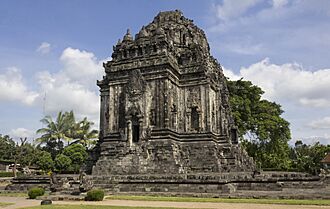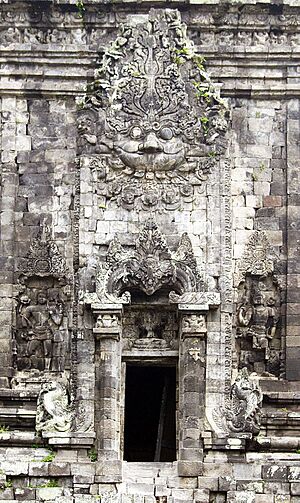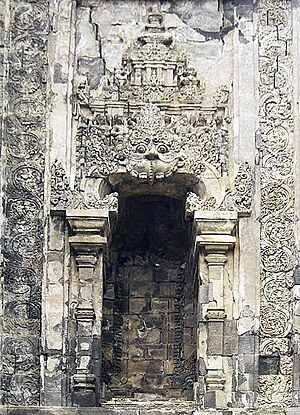Kalasan facts for kids
Quick facts for kids Kalasan TempleCandi Kalasan ꦕꦟ꧀ꦝꦶꦏꦭꦱꦤ꧀ |
|
|---|---|

Kalasan Temple
|
|
| General information | |
| Architectural style | Buddhist candi |
| Town or city | Kalasan, Sleman Regency, Special Region of Yogyakarta |
| Country | Indonesia |
| Coordinates | 7°46′02″S 110°28′20″E / 7.767311°S 110.472335°E |
| Completed | circa 8th century |
| Client | Sailendra |
Kalasan Temple, also called Candi Kalasan or Candi Kalibening, is an ancient Buddhist temple from the 8th century. You can find it in Java, Indonesia. It's about 13 kilometers (8 miles) east of Yogyakarta, on the road to Prambanan temple. This historic site is located in the Kalasan District of Sleman Regency.
Contents
Discovering Kalasan Temple's Past
Kalasan Temple has a long and interesting history. We know a lot about it from an old stone writing called the Kalasan inscription. This inscription is from the year 778 AD. It was written in Sanskrit using a special old script called Pranagari.
How Kalasan Temple Was Built
The inscription tells us that a powerful leader, Guru Sang Raja Sailendravamçatilaka, helped build the temple. He convinced Maharaja Tejapurnapana Panangkaran to create a holy building. This building was named Tarabhavanam, and it was dedicated to the goddess Tara.
A Vihara (which is a monastery for monks) was also built nearby. This was for the Buddhist monks who were part of the Sailendra family's kingdom. Maharaja Panangkaran even gave the village of Kalaça to the Sangha, which is the Buddhist monastic community.
Kalasan: An Ancient Landmark
Because of the date on its inscription, Kalasan Temple is known as the oldest temple built in the Prambanan Plain. This area is famous for many ancient temples.
Even though parts of the temple were fixed up during the time when the Dutch ruled Indonesia, Kalasan Temple is not in the best shape today. It's not as well-kept as some other nearby temples like Prambanan, Sewu, or Sambisari.
Exploring Kalasan Temple's Design
Kalasan Temple sits on a square base that is about 14.20 meters (46.6 feet) wide. The temple itself has a cross shape and is designed with twelve corners.
Inside the Temple
Each of the four main directions (north, east, south, west) has stairs and gates. These gates are decorated with special carvings called Kala-Makara. Inside, there are rooms that are about 3.5 square meters (38 square feet).
The smaller rooms on the north, west, and south sides don't have statues anymore. But, there are lotus-shaped pedestals, which suggest that statues of Bodhisattvas (enlightened beings) once stood there.
Amazing Decorations
The temple is covered with many beautiful Buddhist figures. You can see carvings of Bodhisattvas and Gana (small, chubby figures). A giant Kala face above the southern door is very famous. It shows how skilled the artists were a thousand years ago!
You'll find many niches (small alcoves) both inside and outside the temple. These niches were meant for statues. The outer walls are also richly carved with images of Kala, gods, and other divine beings. These carvings show scenes from the svargaloka, which is like a heavenly palace where gods, apsaras (celestial dancers), and gandharvas (celestial musicians) live.
The Temple's Unique Roof
The roof of Kalasan Temple has three different parts:
- Lower part: This section follows the same polygonal shape as the temple's body. It has small niches with statues of Bodhisattvas sitting on lotus flowers. Each of these niches has a small stupa (a dome-shaped structure) on top.
- Middle part: This section is eight-sided. Each of its eight sides has niches with a statue of a Dhyani Buddha (a type of Buddha) flanked by two standing Bodhisattvas.
- Top part: This part of the roof is almost circular. It also has 8 niches, each topped with a single large dagoba (another word for stupa).
The eight-sided shape of the middle roof has made some people wonder if there are non-Buddhist ideas mixed into the temple's design. This is similar to how some people interpret parts of the early Borobudur temple.
The Main Room and Missing Statue
The temple faces east, and the eastern room is the main entrance to the central room. In this large main room, there is a lotus pedestal and a throne. The throne is carved with figures of makara (mythical sea creatures), lions, and elephants. This is similar to the Buddha Vairocana throne found in Mendut temple.
According to the Kalasan inscription, the temple once held a very large statue of the Boddhisattvadevi Tara. This statue was probably about 4 meters (13 feet) tall! From the design of the throne, it seems the goddess statue was sitting and was made of bronze. Sadly, the statue is now missing. It might have been stolen for its metal over many centuries, just like the bronze Buddha statue from Sewu temple.
The Diamond Plaster
On the outside walls of the temple, you can still see traces of a special plaster called vajralepa. This means "diamond plaster." The same kind of white-yellowish plaster was also found on the nearby Sari temple. This plaster was used to protect the temple walls, but most of it has worn off over time.
Kalasan's Neighbors
Kalasan Temple is located in the Prambanan Plain, an area full of important archaeological sites. Just a few hundred meters northeast of Kalasan Temple is Sari Temple. Candi Sari was likely the monastery mentioned in the Kalasan inscription. Further east, you'll find the famous Prambanan complex, Sewu Temple, and Plaosan Temple.
See also
- Borobudur
- Buddhism in Indonesia
- Candi of Indonesia
- Candi Mendut
- Candi Plaosan
- Candi Sari
- Indonesian Esoteric Buddhism
- Kalasan inscription (778)



